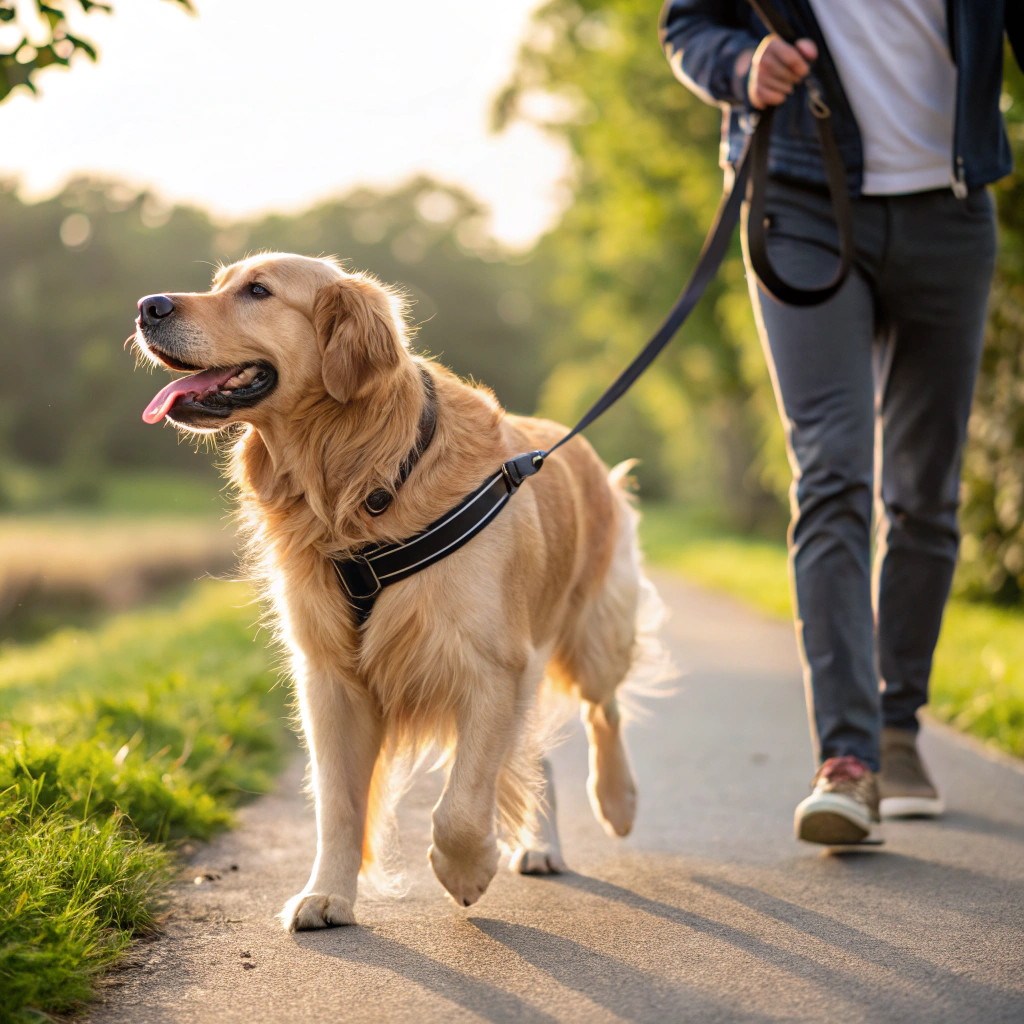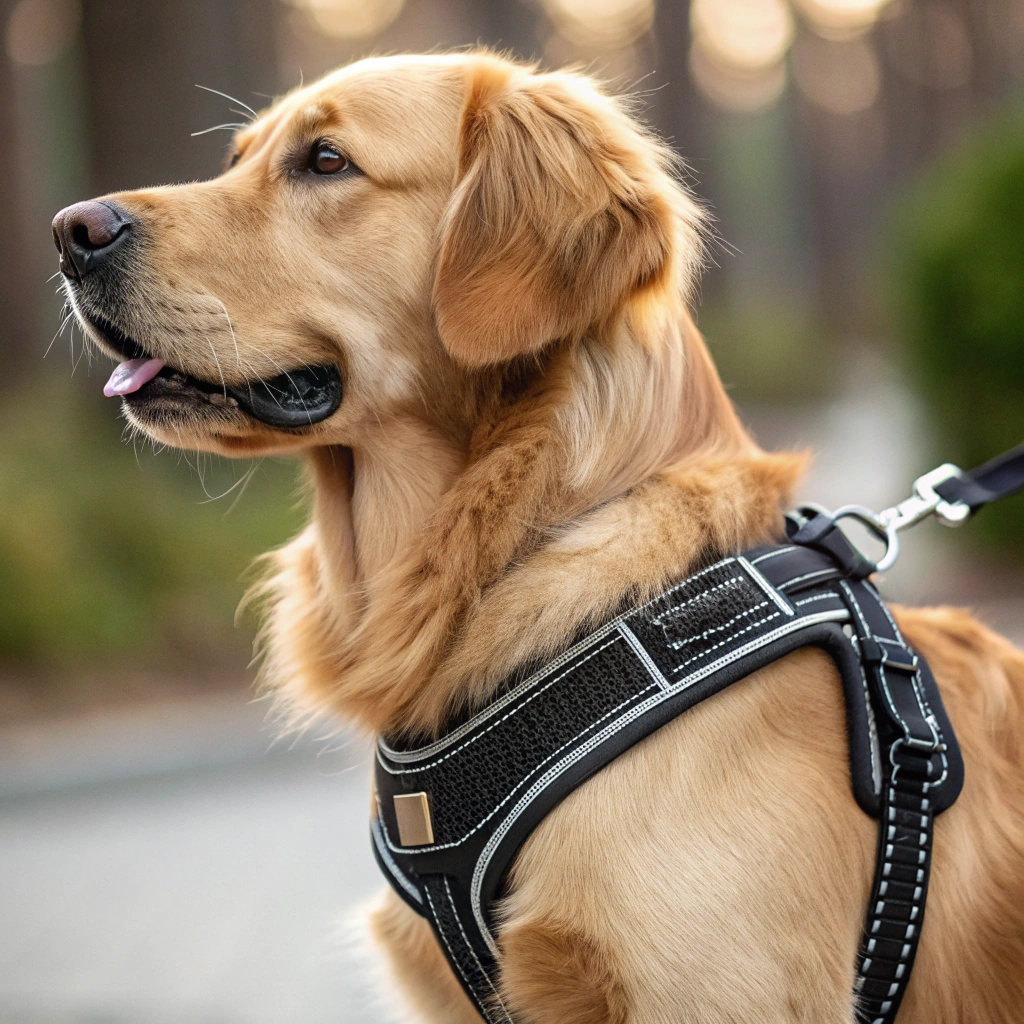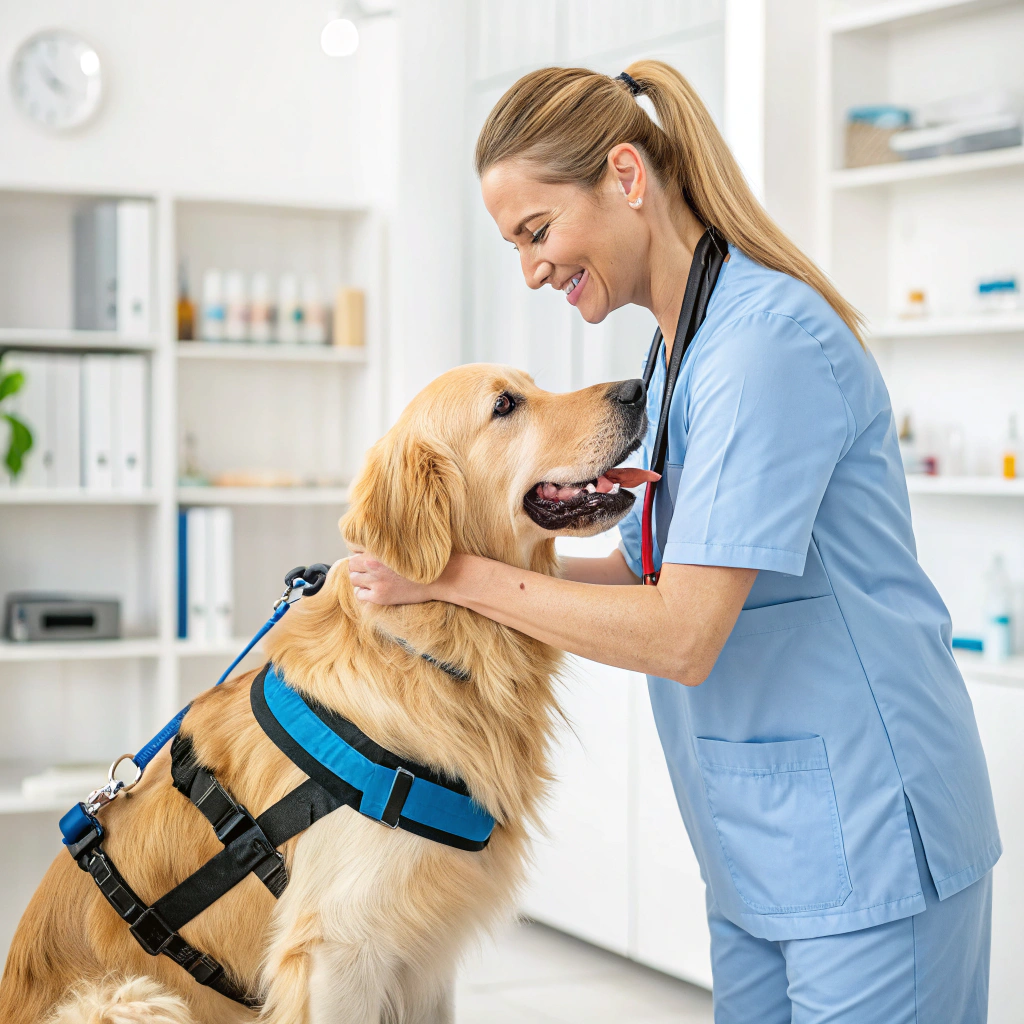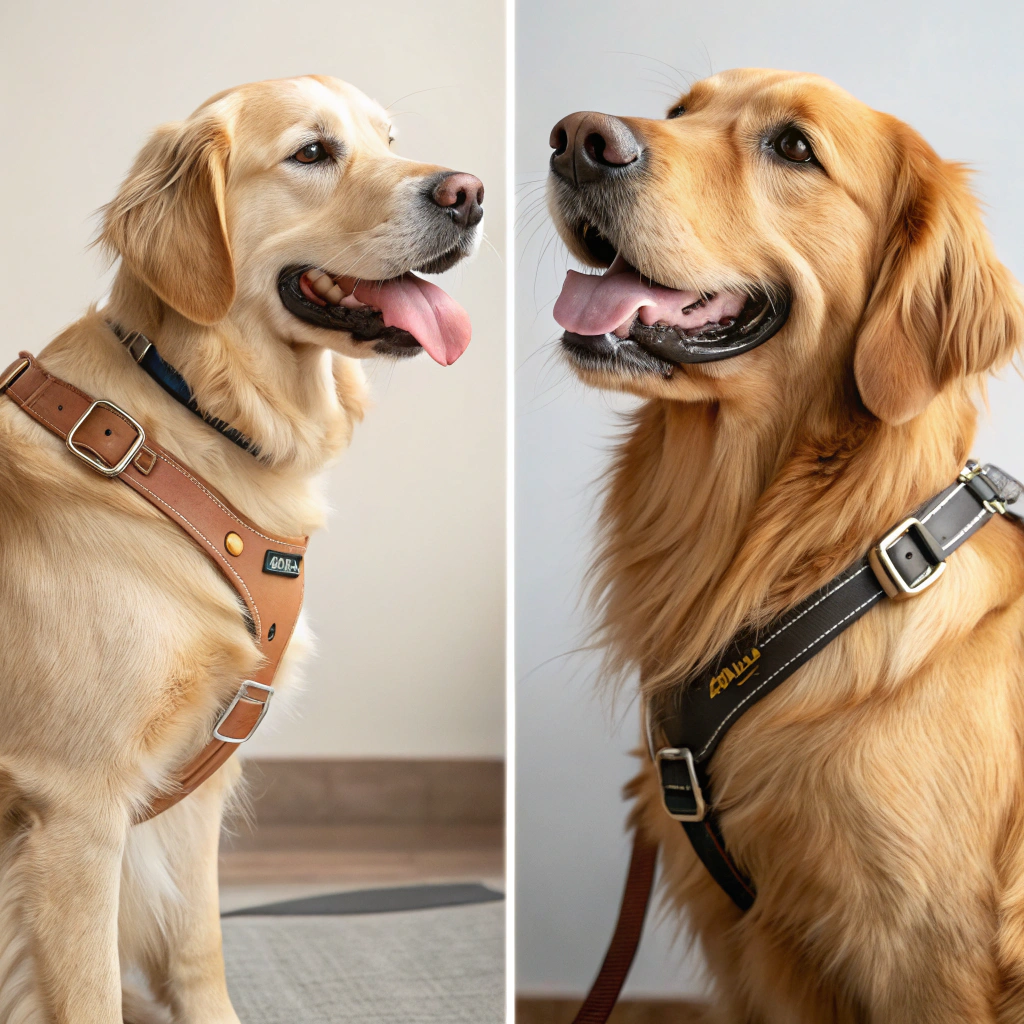What’s the Best Harness with a Handle for Your Golden Retriever?
Your energetic Golden Retriever pulls you down the street, nearly dislocating your shoulder. You’ve tried different collars and basic harnesses, but nothing gives you the control and comfort you both need.
**The best harnesses for Golden Retrievers feature adjustable straps, sturdy handles, front and back attachment points, and The best harnesses for Golden Retrievers feature adjustable straps1, sturdy handles, front and back attachment points, and padded chest pieces

After years of working with Golden Retrievers and testing countless harnesses for my own golden buddy, I’ve learned what features actually matter. Let me share what really works for our gentle giants, based on both personal experience and the collective wisdom of the Golden Retriever community.
What Kind of Harness is Best for a Golden Retriever and Why?
Your beautiful Golden bounds around with endless energy, but walks have become a tug-of-war contest. You worry about hurting their throat with a collar, but You worry about hurting their throat1 with a collar, but standard harnesses don’t provide enough control.
The best harnesses for Golden Retrievers are those with Y-shaped front designs that prevent shoulder restriction, adjustable straps to accommodate their deep chests, and sturdy handles for additional control, with the Ruffwear Front Range being particularly suitable for this breed.

Golden Retrievers have specific physical characteristics that make harness selection particularly important. Their deep chests, muscular build, thick fur, and energetic nature all influence what makes an ideal harness for the breed. After trying countless options with my own Golden, Max, I’ve identified the key features that truly matter.
The chest structure of Golden Retrievers requires special consideration. Their characteristic deep, broad chests mean that harnesses designed for breeds with narrower builds often fit poorly, causing chafing or restricting movement. A properly designed harness for a Golden should feature a Y-shaped front that follows the contours of the chest while keeping straps away from the sensitive armpit area. This design allows for the full range of shoulder movement that Goldens need for their natural gait.
Durability is another crucial factor. Golden Retrievers are active, powerful dogs that love water, mud, and outdoor adventures. A harness that might work fine for a smaller, less active breed will quickly show wear and tear with a Golden. Look for reinforced stitching at stress points and materials that can withstand getting wet and dirty repeatedly. This is why harnesses like the Kurgo Journey, with its rugged materials and construction, tend to last longer for Golden Retrievers.
The handle feature, which is what many Golden owners specifically seek out, serves multiple important functions:
Handle Benefits for Golden Retriever Harnesses
| Benefit | Description | When It’s Useful |
|---|---|---|
| Emergency control | Provides immediate restraint | When your Golden spots wildlife or friendly strangers |
| Assistance over obstacles | Helps lift your dog safely | Hiking over fallen trees or getting in/out of vehicles |
| Water safety | Quick grab point for water rescues | During swimming or water retrieving activities |
| Training aid | Gentle guidance for position training | Teaching heel position or directional control |
| Senior support | Support for dogs with mobility issues | Helping older Goldens navigate steps or slippery surfaces |
From my experience, the top harnesses that meet all these requirements include:
-
Ruffwear Front Range – The padding on this harness prevents the fur matting that’s common with Golden Retrievers, while the handle is positioned perfectly for control without encouraging pulling.
-
Kurgo Journey – This harness has five adjustment points that work well for the Golden’s unique chest shape, and the handle is reinforced enough to actually support their weight when needed.
-
PetSafe 3-in-1 – The neoprene padding on the chest prevents the chafing that Golden Retrievers often experience with less padded harnesses, and the handle placement works well for their center of gravity.
One often overlooked consideration is how the harness interacts with a Golden’s thick double coat. Certain materials can cause Certain materials can cause Certain materials can cause fur matting or breakage, especially around the friction points1 under the chest and behind the front legs
Finally, the ideal Golden Retriever harness should grow with your dog, both in terms of size adjustability and functionality. Many Golden owners find that a harness with both front and back attachment options provides versatility as training progresses. Using the front attachment helps discourage pulling during training, while the back attachment can be used once leash manners improve.
What Harness Do Vets Recommend for Golden Retrievers and Other Large Breeds?
Your Golden’s health is your top priority, but with so many harness options claiming to be "vet-approved," it’s hard to know what’s actually best for your dog’s physical wellbeing. You need clarity from actual professionals.
Veterinarians typically recommend harnesses that distribute pressure across the chest rather than the neck, with most favoring Y-shaped front designs like the Blue-9 Balance Harness or Ruffwear Front Range that don’t restrict shoulder movement or gait.

When discussing harnesses with veterinarians, their recommendations consistently prioritize long-term orthopedic health and natural movement patterns. This perspective is particularly valuable because vets regularly see the consequences of poor harness choices—from gait abnormalities to exacerbated joint issues.
I recently spoke with Dr. Amanda Chen, a veterinarian specializing in canine sports medicine, who emphasized that harness selection for Golden Retrievers should account for their predisposition to certain orthopedic conditions. "Golden Retrievers are already prone to shoulder and elbow issues," she explained. "A poorly designed harness that restricts the shoulder’s natural motion can potentially contribute to problems down the road, especially for active dogs."
The veterinary consensus generally favors harnesses with these specific characteristics:
Veterinarian-Recommended Harness Features
| Feature | Veterinary Rationale | Example Products |
|---|---|---|
| Y-shaped chest design | Preserves natural gait mechanics | Blue-9 Balance, Ruffwear Front Range |
| No chest compression | Prevents altered stride patterns | Perfect Fit, 2 Hounds Design Freedom |
| Adjustability at multiple points | Ensures proper weight distribution | Kurgo Journey (5 adjustment points) |
| Padding at pressure points | Reduces risk of soft tissue injury | Ruffwear Web Master, PetSafe 3-in-1 |
| Proper fit across shoulders | Avoids restriction of movement | Balance Harness, Perfect Fit modular system |
Dr. Michael Torres, a veterinary orthopedic specialist I consulted with at a recent Golden Retriever health clinic, pointed out that "the harness with the sturdiest handle isn’t necessarily the best choice if it doesn’t fit properly in other areas." He recommends theHe recommends the Blue-9 Balance Harness for Goldens specifically because its nine-point adjustment system1 allows for precise fitting around their unique chest structure while maintaining proper shoulder motion.
For Golden Retrievers with existing orthopedic issues, veterinary rehabilitation specialists often suggest the Help ‘Em Up Harness, which features handles at both the front and rear. While bulkier than everyday walking harnesses, this design provides superior support for dogs recovering from surgery or seniors with mobility challenges.
Veterinarians are also increasingly concerned about the impact of improper harness use during water activities—something Golden Retrievers frequently enjoy. Dr. Lisa Wong, an aquatic rehabilitation specialist, cautions against using standard harnesses for water retrieval: "A harness that’s perfect for land can become waterlogged and potentially restrictive during swimming. For water-loving Goldens, consider a specific water sport harness like the Ruffwear Float Coat if water activities are frequent."
It’s worth noting that veterinary opinions can differ based on their specialty and the specific needs of individual dogs. For instance, a general practice veterinarian might recommend a simple, well-fitted Y-front harness for most healthy Goldens, while a rehabilitation specialist might suggest more specialized supportive equipment for dogs with specific conditions.
One consistent recommendation from veterinarians is to regularly check and adjust your Golden’s harness as their weight, coat, and activity levels change throughout the year. A properly fitted harness should allow you to slip two fingers between the harness and your dog’s body at any point, while remaining secure enough that they can’t back out of it.
Should a Golden Retriever Wear a Harness Instead of a Collar and When?
Your Golden Retriever enthusiastically greets everyone with jumping and pulling, making walks stressful and potentially dangerous. You wonder if switching completely to a harness is the right move or if there are times when a collar is still appropriate.
Golden Retrievers benefit from wearing harnesses instead of collars during walks, training, and activities due to their enthusiastic pulling habits and risk of tracheal damage. Harnesses distribute pressure across the chest rather than the neck, reducing injury risk while providing better control.

The decision between harness and collar use for Golden Retrievers isn’t simply a matter of preference—it has real implications for their health, training progress, and overall quality of life. As someone who’s raised several Goldens and worked with many more, I’ve seen firsthand how this choice impacts their wellbeing and behavior.
Golden Retrievers as a breed have several characteristics that make harnesses particularly beneficial. Their friendly, exuberant nature often leads to excited pulling toward people, other dogs, or interesting scents. This pulling behavior, when restrained by a collar, places significant pressure on their throat and neck. Studies have shown that even moderate pulling against a collar can increase intraocular pressure and cause concerning tracheal and neck strain.
Dr. Karen Becker, a proactive veterinary advocate I follow closely, notes that thyroid issues—already common in Golden Retrievers—can potentially be exacerbated by consistent pressure on the neck from collar pulling. Given that Goldens are predisposed to hypothyroidism, minimizing this risk through harness use makes sense from a preventative health perspective.
However, this doesn’t mean collars have no place in your Golden’s life. There are specific scenarios where each option—harness, collar, or both—makes the most sense:
When to Use Harness vs. Collar for Golden Retrievers
| Scenario | Recommended Equipment | Reasoning |
|---|---|---|
| Daily walks | Harness | Prevents tracheal pressure, provides better control |
| Training sessions | Harness with front clip | Discourages pulling, gives directional control |
| Off-leash play | Collar with ID tags | Provides identification without bulk |
| Swimming/Water work | Water-specific harness | Safety handle for water retrieval, buoyancy |
| Car travel | Harness with crash testing | Safety restraint in case of accident |
| Multi-dog household | Both (harness for walks, collar for ID) | Quick identification, controlled walking |
Many Golden Retriever owners, myself included, find that the best approach is using both: a flat collar that’s worn continuously for ID purposes (with tags and possibly a GPS tracker for these adventure-loving dogs), and a harness that’s put on specifically for walks, training, or activities.
For Goldens that participate in specific activities, specialized harnesses may be appropriate. For instance, those involved in tracking or nose work might benefit from a tracking harness that allows free shoulder movement while providing different balance points. Competition obedience Goldens might use a more minimalist harness during training that meets Competition obedience Goldens might use a more minimalist harness1 during training that meets regulation requirements.
A common concern I hear from Golden owners is about harnesses causing matting in their thick double coats. This is a legitimate issue, but can be managed by:
- Choosing harnesses with smooth, padded straps rather than rough webbing
- Removing the harness when not in use rather than leaving it on constantly
- Regularly brushing the areas where the harness sits, especially under the chest and behind the front legs
- Considering a well-fitted Y-front design that minimizes coat contact points
It’s worth noting that harness use doesn’t replace training—it’s a management tool that creates better conditions for training success. The goal should be teaching your Golden to walk politely on leash with minimal pulling, regardless of the equipment used. A harness simply makes this training process more humane and effective by removing the reinforcement that comes from successful pulling against a collar.
For my own Golden, I found that using a front-clip harness during our structured training sessions, combined with positive reinforcement for loose-leash walking, eventually allowed us to transition to calm walking regardless of whether he was wearing his harness or just his regular collar. The harness was the tool that made the training possible, but the training itself was what ultimately changed his behavior.
Conclusion
For Golden Retrievers, a well-fitted Y-shaped harness with sturdy handle, multiple attachment points, and proper padding proves most effective for their unique build and energetic nature. Veterinarians consistently recommend designs that don’t restrict shoulder movement while distributing pressure evenly across the chest. While collars remain useful for ID purposes, harnesses offer superior control and safety during walks and activities, making them the preferred choice for responsible Golden Retriever owners focused on their dog’s long-term health and comfort.

